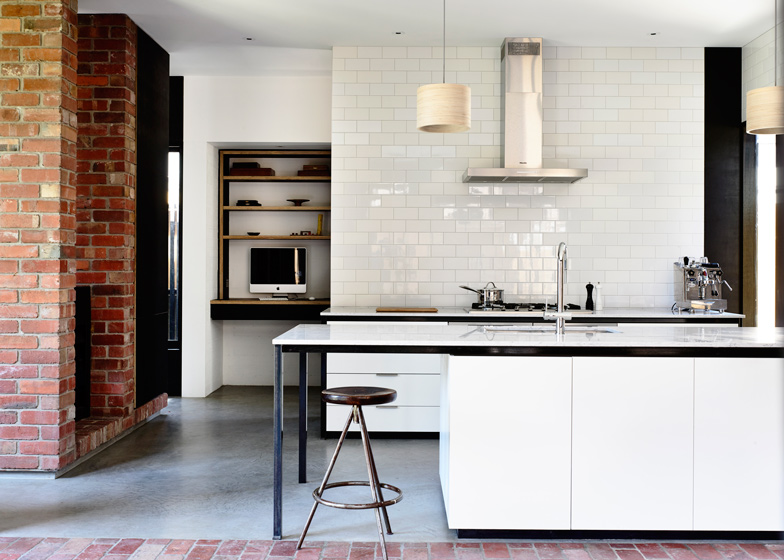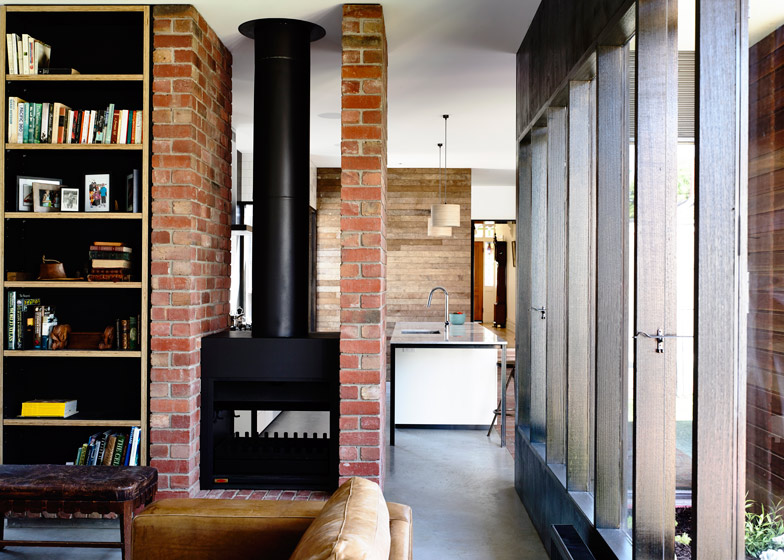Australian studio Wolveridge Architects ran a brickwork pathway through the inside and outside of this timber-clad extension to a house in Melbourne, using old bricks found in the garden (+ slideshow).
Named Northcote Residence, the project involved removing an out-dated annex from the house located in Melbourne's inner north suburb, then adding a new L-shaped extension that more than doubles the original floor space and creates new living spaces.
Wolveridge Architects used the scale and proportions of the existing house as a guide when developing the form of the new structure, but the team was still keen to create a clear junction between old and new.
"The new works are not visible from the street; however that did not diminish our intention for the physical form to establish a connection to the existing dwelling," said the team.
"A dialogue established between old and new conveys a sense of relevance that lends integrity to the design. The incorporation of red bricks from the site has been extensive and recalls a historical notion of a previous life," they added.
The salvaged red bricks create a pathway that starts at the rear of the original residence, stretches through the living spaces and garden, then finishes beside a new swimming pool.
These are complemented by other exposed materials, which include timber cladding for both internal and external walls and black-stained plywood joinery.
"Where possible, we have incorporated recycled materials," said the team. "Those finishes lend a robust yet valuable quality."
The L-shaped layout of the open-plan living room and kitchen wraps around the north-facing garden. A sheltered terrace runs along one edge, while the new swimming pool sits opposite.
White ceramic tiles define the space of the kitchen and a small study sits within an alcove. Two brick walls also frame a fireplace.
The final addition was a wine cellar, located within a new basement beside the swimming pool.
Photography is by Derek Swalwell.
Here's a project description from Wolveridge Architects:
Northcote Residence by Wolveridge Architects
The context for this project is largely related to heritage, Melbourne's inner north suburbs where housing stock is generally freestanding, open to the street and light framed construction. The subject dwelling comprises an asymmetrical facade and central corridor adjoining two rooms either side as typical. Our brief called for the demolition of a poor rear alteration and construction of extensions in its place. The works comprised a renovation of the existing building and new single storey rear additions incorporating pool, cellar and the main living facilities for a young family.
The site planning was laid out to respond and maximise solar gain with the long northerly boundary. To achieve this, the bulk of the new work was built up to the south and rear eastern boundary, save for light and ventilation wells that span the south boundary. The design response was concerned with how the new work would connect with the existing building in a physical sense. An internal brick path, constructed from bricks found on the site formed the junction between old and new and continued from entry, comprising the new work and terminating with a garden outlook.
The existing conditions were extremely poor with ordinary day light that required artificial support during the day and a challenged connection with the outdoor space. The inhabitants now enjoy a well zoned home that retains a sense of the intimacy that relates to the scale of the original home. The occupants enjoy natural light, fresh breezes through the habitable spaces and improved recreational conditions including a swimming pool. The living room has a TV, but is hidden behind a sliding polished plaster screen and now the record player has emerged after years in a box.
The new works are not visible from the street; however that did not diminish our intention for the physical form to establish a connection to the existing dwelling. The connecting elements in plan, the laundry and kids bathroom incorporates a lower roof with the spring height of the existing dwelling recognised at the roof height of the new work. A dialogue established between old and new conveys a sense of relevance that lends integrity to the design. The incorporation of red bricks from the site has been extensive and recalls a historical notion of a previous life.
The program laid out a response both to the requirements of the brief in conjunction with how those spaces should make best use of the site. Logically a central living arrangement with a connected kitchen/dining, but separated and more intimate scale living area was agreed. The L-shape of the living spaces enabled more spaces to connect with the north facing garden and pool. Storage requirements were large and provided accordingly. A separation of parents and kids rooms was accommodated and the physical demarcation between the old and new parts of the house has translated strongly providing historical reminders.
This project enjoyed the benefits of a proactive builder whose original estimate remained very close to the eventual construction figure. McKerlie's contribution assisted us in many ways. An example was how to deal with the client's requirement for incorporating a wine cellar (one of the owners is a wine maker). And our response was to locate is sub ground adjacent to and as part of the pool structure. Together with the project engineer, this was resolved and constructed efficiently and economically.
We sought submissions from a number of suitable builders for this project at the time concepts were being prepared. On the basis of those submissions, one builder was selected. He agreed to work through the detail design and his contribution meant that the eventual contract sum remained very close to his estimate. We think the project incorporates a high level of detail resolution, incorporation of durable, quality materials for a very reasonable cost. Where possible, we have incorporated recycled materials – bricks, internal timber cladding and black stained plywood internal lining. Those finishes lend a robust yet valuable quality.
The project incorporates an extensive number of passive design features. The south and east walls are generally reverse or insulated double brick on concrete slab. As the living areas all face north, sun studies were undertaken to omit high summer sun from the dwelling's interior, yet encourage the entry of the low winter sun. This was assisted by elevating sills 400mm above floor level, which provided a zone for hydronic heating panels. The long length of the new work provided opportunities for light and ventilation wells along the southern side of the building.
Each new habitable room benefits from cooling southerly breezes. During this summer's 45 degree heat, the owners had just moved in and reported internal temperatures of around 27 degrees. We encouraged the clients not to invest in air-conditioning, but just to relocate an existing one to the home office. 2KW of grid connected solar panels were provided, solar hot water, all of which are located in a north facing roof that is otherwise not visible from any aspect in the garden. All new windows are double glazed and casement openables are terrific for ventilation. The energy rating for the new work exceeds 6 stars.
Lead architect/designer: Jeremy Wolveridge
Team members: Ricky Booth (Project Architect), Moritz Kitzmann (Assistant Architect)
Builder: McKerlie Builders
Engineer: Keith Long & Associates
Landscape: Liz Turner
Interior: Wolveridge Architects
Lighting: Wolveridge Architects












